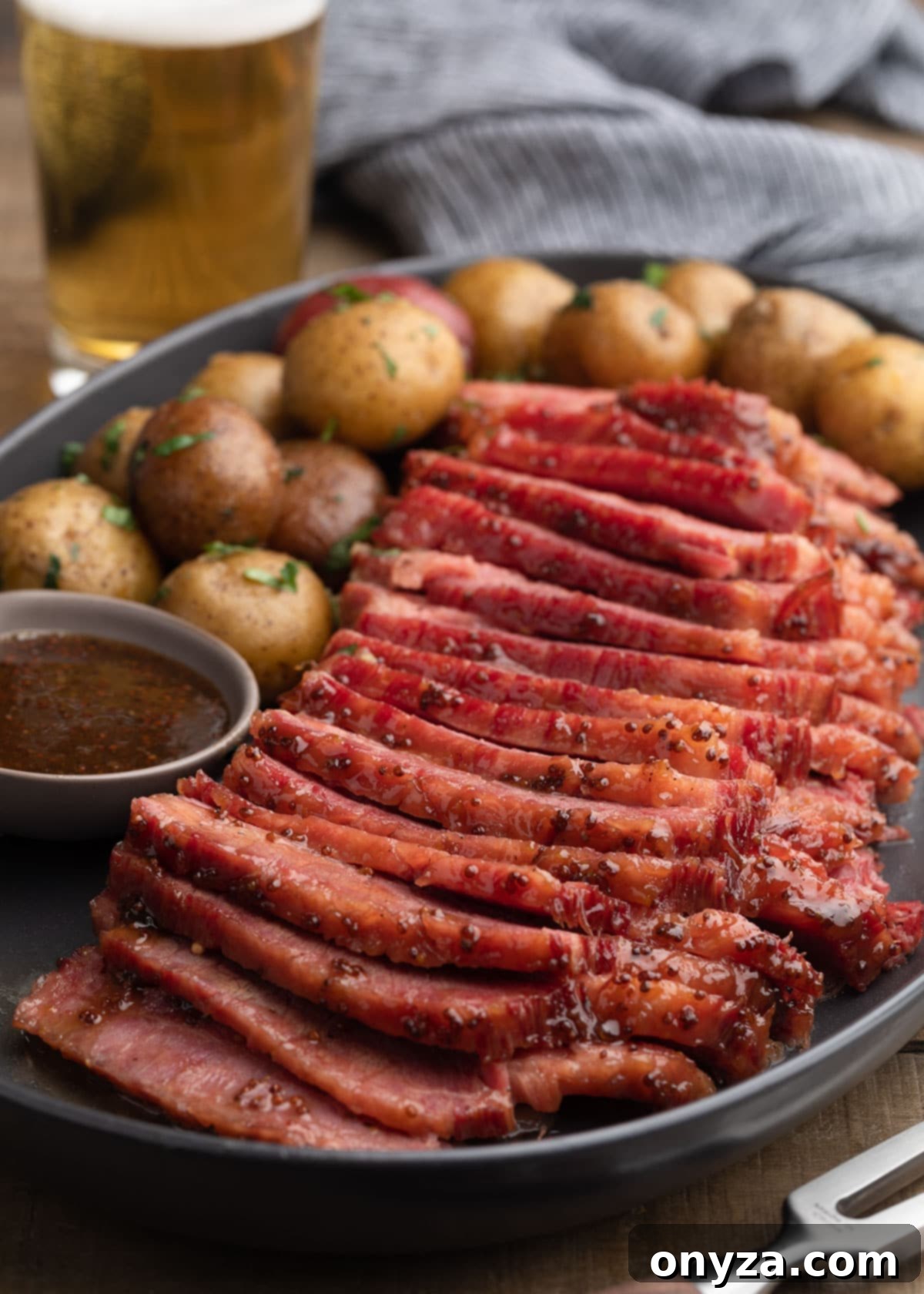Crafting the Ultimate St. Patrick’s Day Feast: Beer-Braised Corned Beef with an Irresistible Whiskey-Mustard Glaze
This post contains affiliate links. As an Amazon Associate, I earn a commission (at no additional cost to you) from qualifying purchases made by clicking these links. As always, all recommendations and opinions expressed are my own.
St. Patrick’s Day is a time for celebration, often centered around hearty, comforting food that pays homage to Irish traditions. While classic corned beef and cabbage holds a special place, this recipe elevates the experience to an entirely new level. Imagine succulent, fall-apart tender corned beef brisket, slow-cooked in a rich beer broth, then glazed with an intoxicating blend of brown sugar, tangy mustard, and smooth Irish whiskey. It’s a dish that promises to be the star of your holiday table, transforming a beloved classic into an unforgettable culinary masterpiece.
The journey to this extraordinary dish begins with the time-honored technique of braising. Braising, a method I’ve long cherished for its ability to transform tough cuts of meat into remarkably tender and flavorful experiences, is the heart of this recipe. Whether it’s Hard Cider Braised Chicken, delicate White Wine Braised Leeks, or robust Stout-Braised Short Ribs, the magic of a tipsy braising liquid never disappoints. This method ensures that every fiber of the corned beef is infused with deep, complex flavors, resulting in a dish that is both profoundly satisfying and incredibly moist.
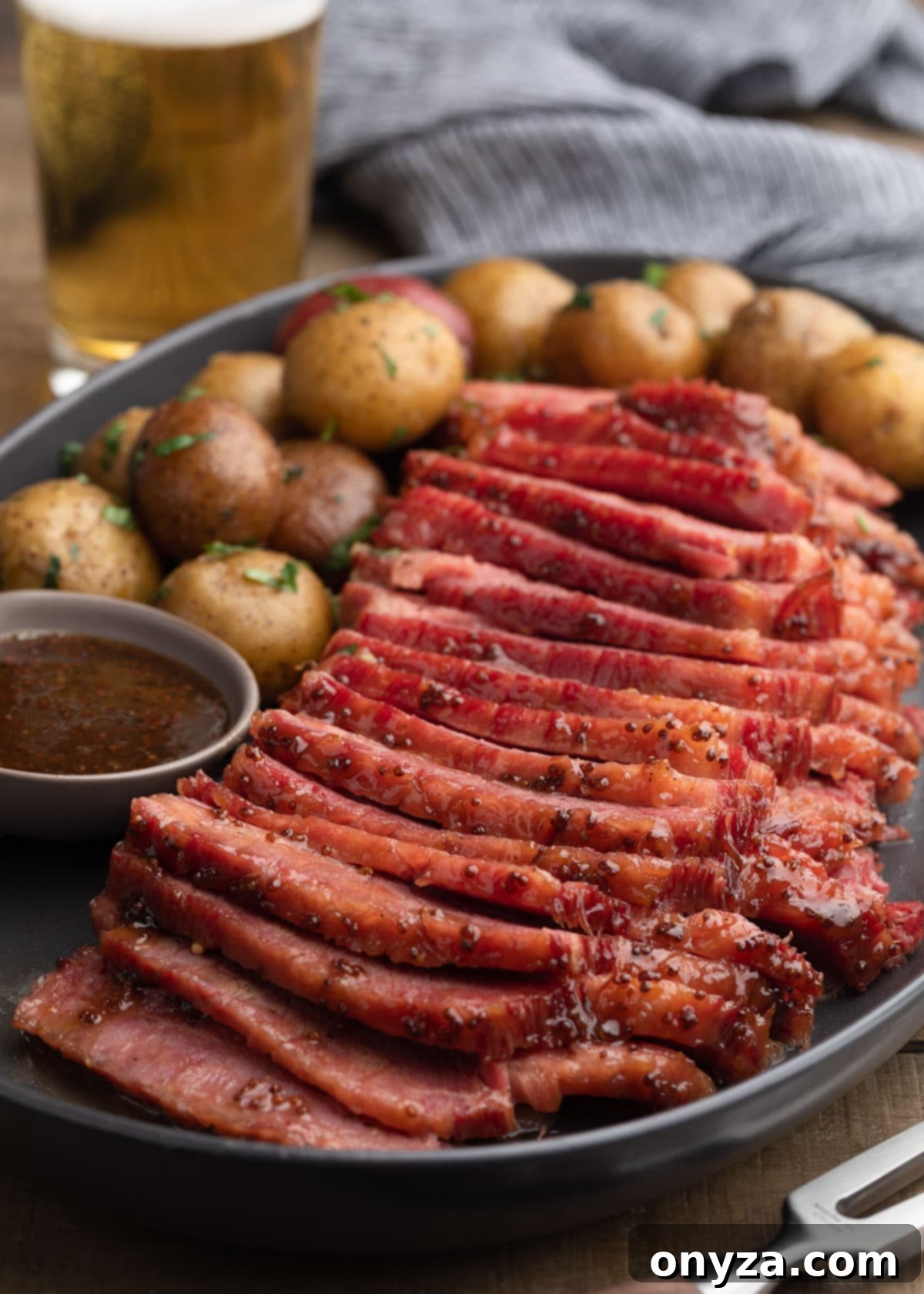
Years ago, I developed a habit of slowly cooking my corned beef with aromatic vegetables and beer in a covered Dutch oven. This technique, a modified braise that skips the initial searing step, consistently yields an exceptionally tender and delicious brisket. However, one year, I decided to introduce a game-changing twist: an **Irish whiskey-spiked mustard glaze**. Since mustard is a traditional accompaniment to corned beef, it seemed only natural to incorporate that vibrant flavor directly onto the brisket itself. This combination of slow braising and a savory-sweet glaze has since become a cherished tradition at my St. Patrick’s Day gatherings, offering a fresh, elevated take on a classic dinner.
Choosing Your Corned Beef Brisket: Flat Cut vs. Point Cut
When you’re shopping for corned beef, which is essentially brine-cured beef brisket, you’ll typically find two main cuts: the flat cut and the point cut. For this specific recipe, I lean towards the leaner “flat cut.” Its uniform thickness makes it incredibly easy to glaze evenly and slice beautifully, presenting a more polished final dish. While the “point cut” is thicker and boasts more marbling—which I certainly appreciate for other preparations—its irregular shape can make the glazing and slicing process a bit more challenging.
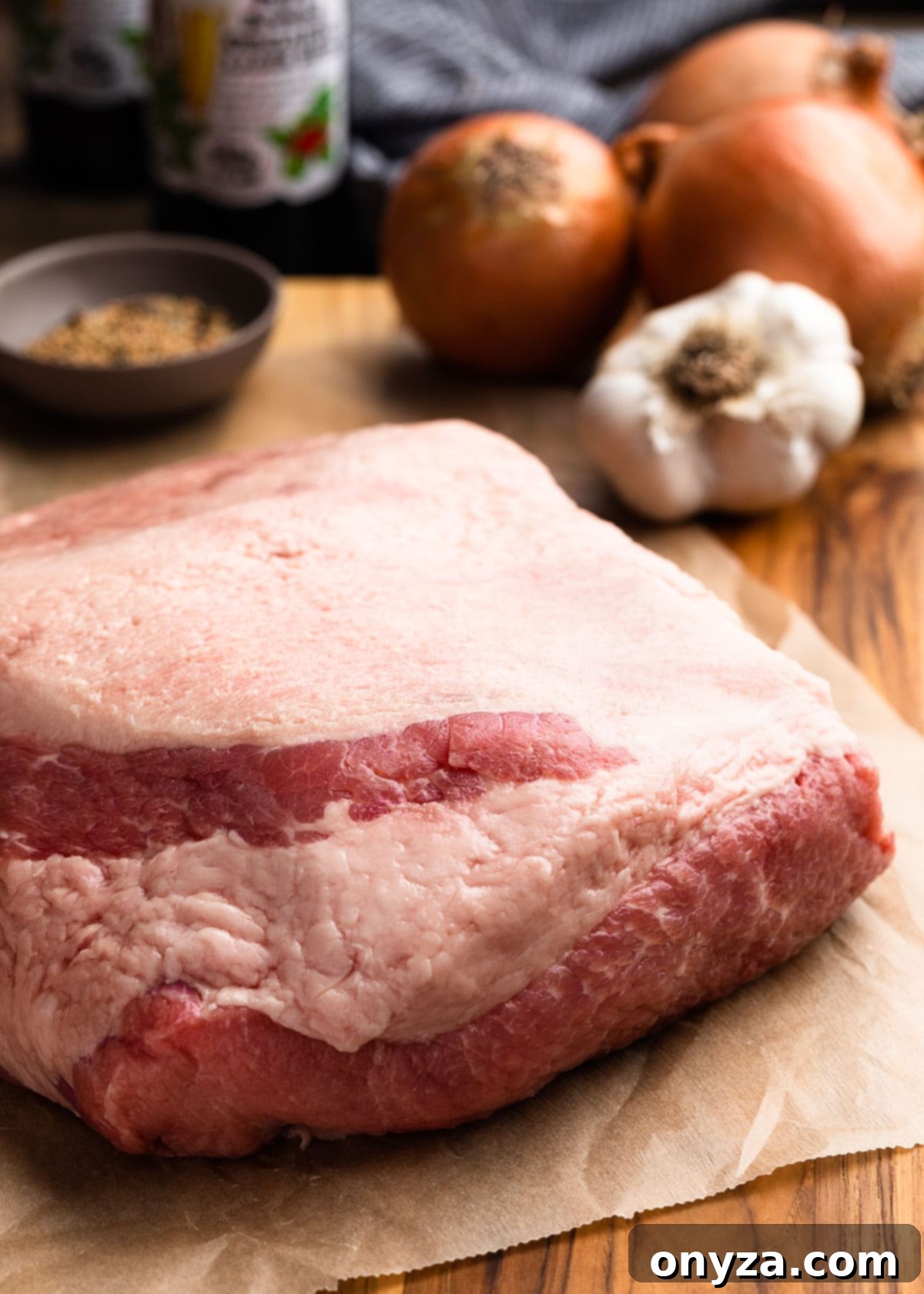
That said, if you have a preference for the point cut or it’s simply what’s available, feel free to use it. The braising method will still render it wonderfully tender. Most corned beef briskets come with a seasoning packet, which is perfect for adding to your beer braising liquid. If yours doesn’t, a jar of pickling spice is readily available in most grocery stores or online, and will provide the essential aromatic notes.
The Allure of Homemade Corned Beef
For the truly adventurous home cook, “corning” your own beef brisket is an incredibly rewarding endeavor. It’s a multi-day process, but the depth of flavor and exquisite texture of homemade corned beef are unparalleled. I first discovered this fascinating process in Michael Ruhlman’s exceptional book, Charcuterie: The Craft of Salting, Smoking, and Curing. This book is an unsolicited plug, but truly one of my favorite “cooking project” books on my shelf for good reason! Ruhlman has also graciously shared a tutorial on his website, making it accessible for anyone eager to try this traditional curing method. Whether store-bought or homemade, the foundation of a great corned beef dish lies in the quality of the brisket.
The Liquid Gold: Selecting the Perfect Beer for Braising
The choice of beer for your braising liquid is paramount, as it deeply influences the final flavor profile of the corned beef. While it might be tempting to reach for a strong, dark stout, experience has taught me that a lighter touch yields the best results for this particular recipe. I typically use Samuel Smith’s Old Brewery’s organic lager from Tadcaster, England. A recommendation from a knowledgeable associate at my local liquor store, this beer has never disappointed. It’s a fresh, crisp, and lightly floral lager that enhances the savory notes of the corned beef without overpowering it, creating a beautifully balanced and harmonious flavor.
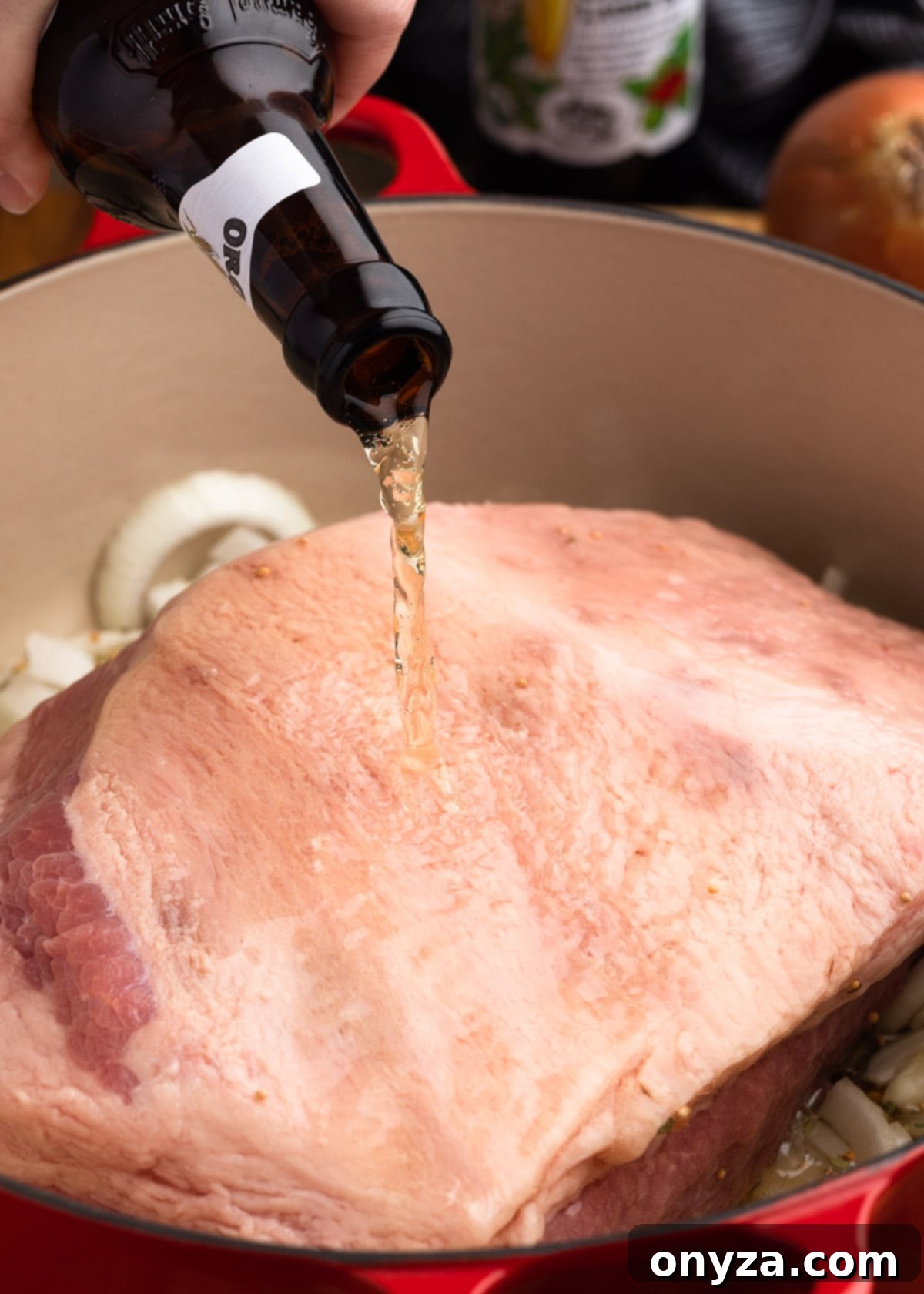
Generally, when choosing a beer for braising, look for a golden lager or a light ale that isn’t overly hops-assertive. The braising process concentrates the flavors, meaning that any bitterness from heavy hops will intensify, potentially leading to an undesirable metallic or overly bitter taste in your meat. You want a beer that will infuse the meat with a pleasant aroma and subtle depth, rather than dominating the palate. Most standard commercial lagers work wonderfully for this purpose. For instance, I’ve had great success using Sam Adams Boston Lager several times when preparing my Instant Pot Corned Beef.

While I adore stout-braised meats, and Guinness is a fantastic brew, using it for this specific corned beef recipe proved to be a bit too much for everyone at the table one year. The robust, roasted notes of the stout, once concentrated, overshadowed the delicate flavors of the brisket. I concluded that it’s best to save the stout for a glass, enjoyed alongside the finished corned beef, rather than incorporating it into the cooking liquid for this particular preparation. The goal is enhancement, not overshadowing.
The Signature Touch: Irish Whiskey-Mustard Glaze
For those looking to add an extra layer of elegance and flavor to their traditional corned beef dinner, this whiskey-mustard glaze is the perfect finishing touch. It’s a harmonious blend of sweet, tangy, and savory, designed to complement the salty richness of the braised brisket. The brown sugar provides a lovely caramelized sweetness, which beautifully contrasts with the sharp, piquant notes of the mustard. I enjoy using a combination of both smooth and whole grain Dijon mustard to add a little textural interest, along with the distinct warmth and subtle complexity of Irish whiskey.
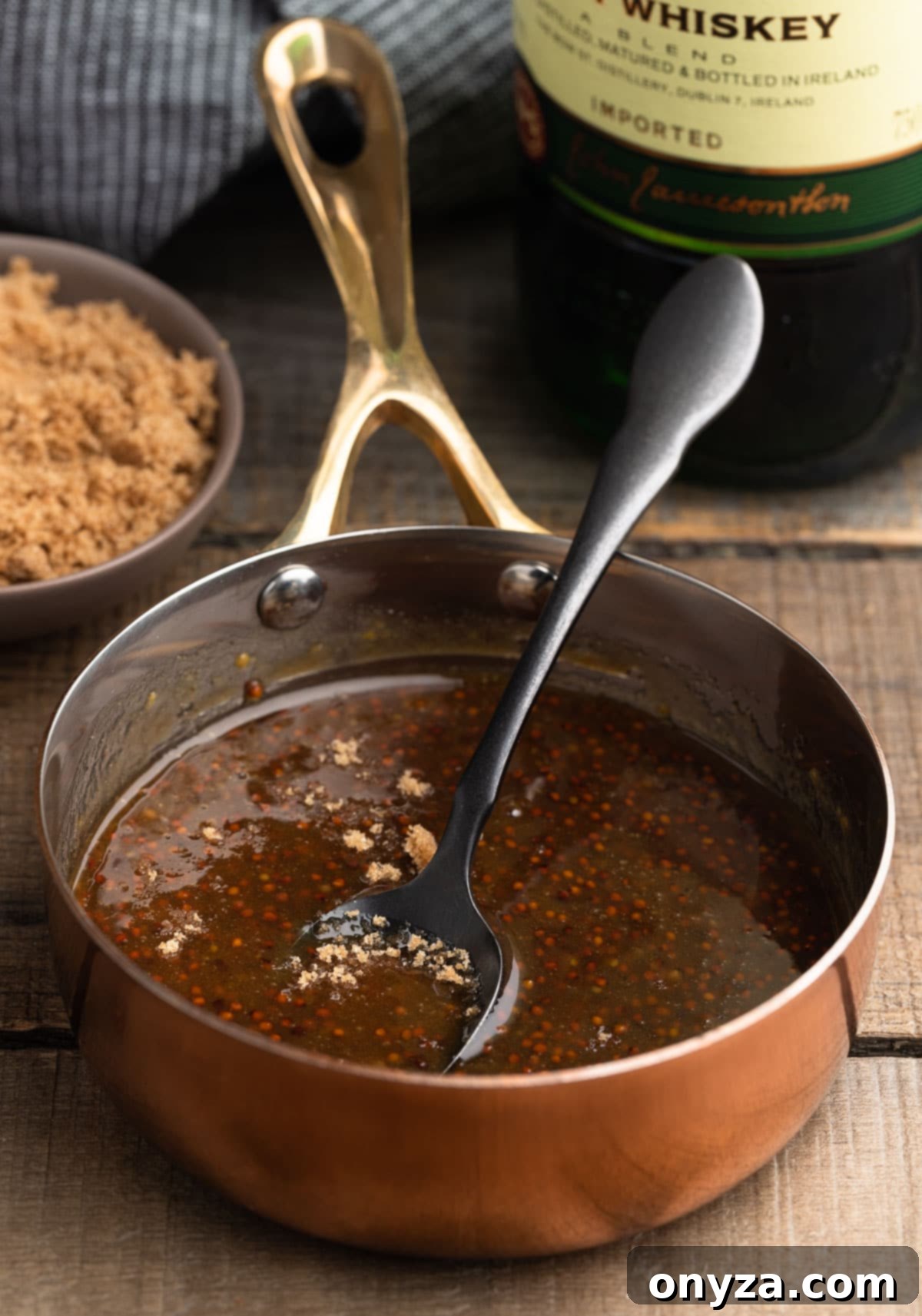
Applying the glaze is incredibly simple. Once your corned beef is perfectly braised and tender, you’ll brush this irresistible mixture over the brisket and pop it under the broiler for just a few minutes until it caramelizes beautifully. This step creates a glossy, slightly crisp crust that locks in moisture and adds an explosion of flavor. However, it’s crucial to watch it very carefully, as glazes with sugar can go from perfectly caramelized to burnt in a matter of seconds. Keep a close eye on it to achieve that ideal golden-brown finish.
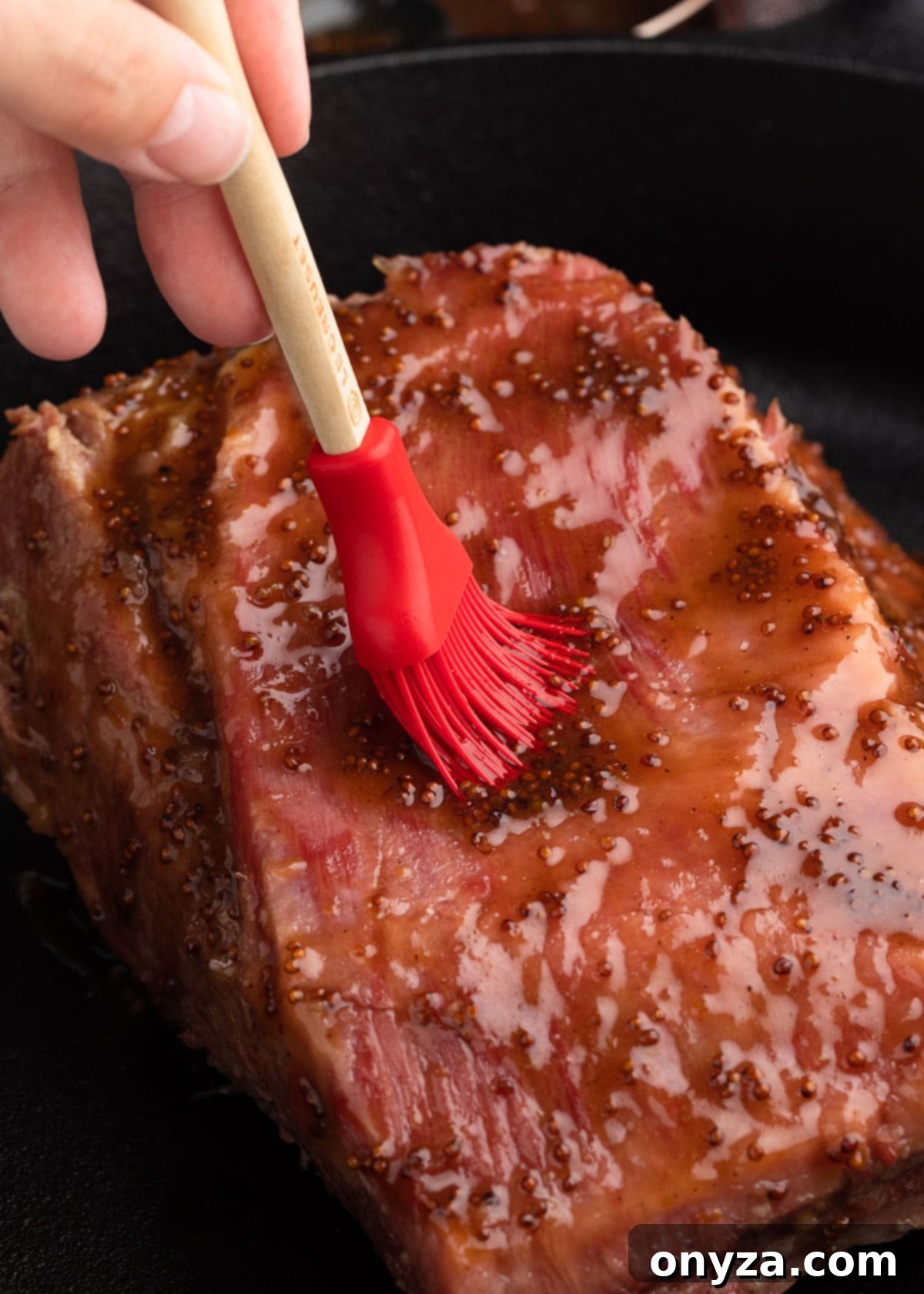
While the glaze truly elevates this dish, it’s also entirely optional. If you prefer a simpler preparation, perhaps you’re making corned beef specifically for classic Reuben sandwiches, or simply aren’t a fan of sweet elements with your savory meats, you can absolutely skip the glazing process. The beer-braised corned beef itself is thoroughly delicious and stands perfectly on its own, a testament to the power of slow cooking.
Can I Add Cabbage and Potatoes to Beer-Braised Corned Beef?
Absolutely! Incorporating traditional cabbage wedges and whole baby red potatoes directly into the pot with the brisket is a fantastic way to create a complete, one-pot meal. The vegetables will absorb the wonderful flavors of the braising liquid, making them incredibly savory and tender. However, there are a few considerations to keep in mind to ensure optimal results.
The beer braising liquid, especially from store-bought corned beef, can be quite salty. When I’m cooking vegetables alongside the meat, I’m particularly mindful of the timing. I typically add the potatoes about one hour before the corned beef is expected to finish braising. This allows them enough time to become tender without becoming mushy or overly salty.
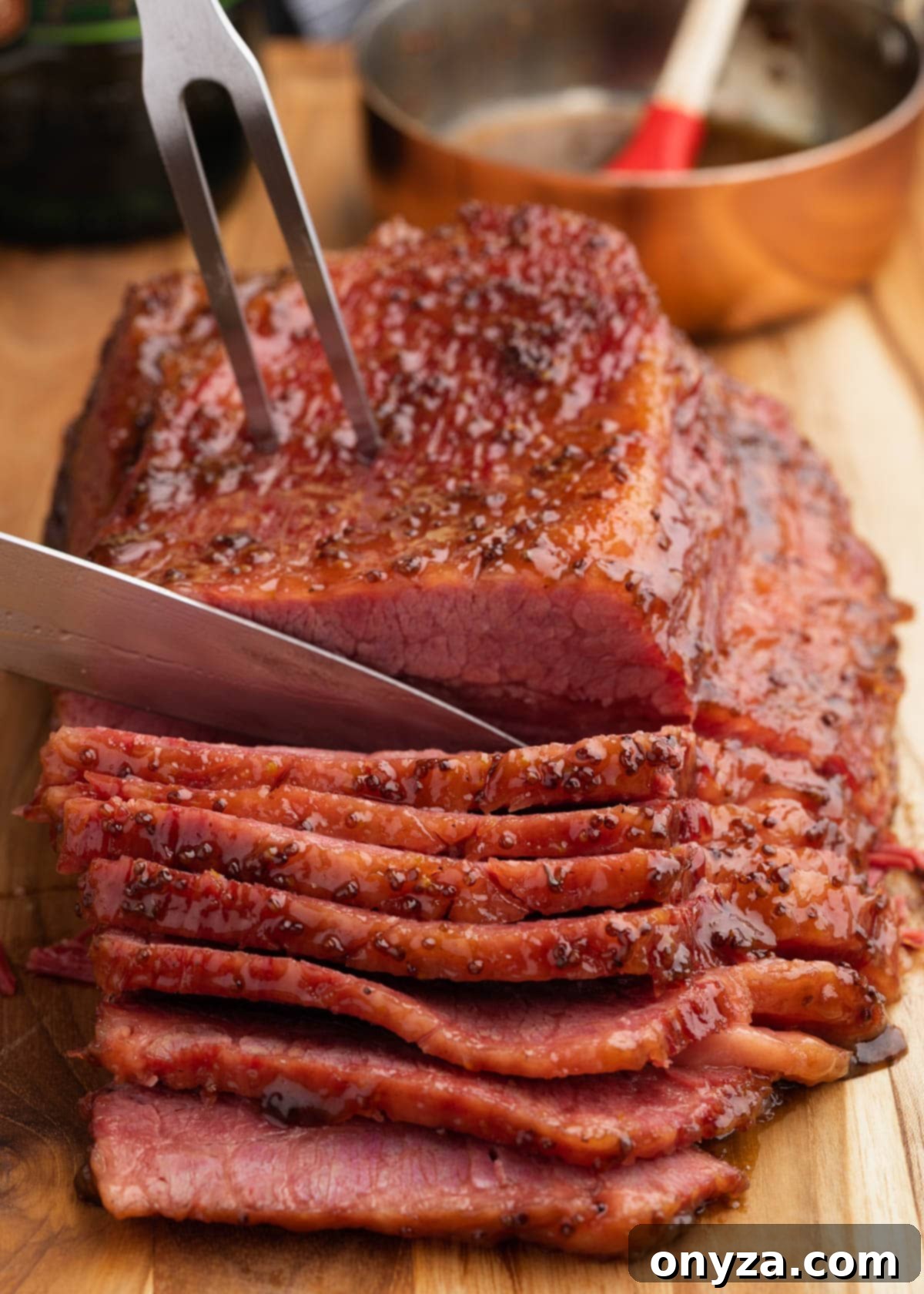
For the cabbage, I like to take an extra step for added flavor. I quickly **sear the cabbage wedges on the stove** in a skillet with a little oil over medium-high heat until they develop a light caramelization. This brief searing process adds a beautiful depth of flavor and texture to the cabbage. With about 30 minutes remaining in the corned beef’s braising time, I add these seared cabbage wedges to the pot.
An important tip: when the corned beef is ready for glazing, I make sure to remove the cooked vegetables from the braising liquid and keep them warm. Letting them sit in the salty liquid while the beef is under the broiler can sometimes make them too salty. When I’m ready to serve, I strain the braising liquid and spoon a little bit of it over both the sliced meat and the vegetables. This not only adds moisture but also infuses every bite with extra savory flavor. And, for an added touch of indulgence, a drizzle of melted butter over the potatoes and cabbage is always a welcome addition!
Alternatively, if you prefer, you can serve this magnificent corned beef with other delightful sides like crispy Roasted Cabbage Wedges or a bowl of creamy Colcannon. Whatever you choose, be sure to have plenty to go around!
Beyond the Holiday: Creative Corned Beef Leftovers
One of the best things about making a delicious corned beef is the prospect of leftovers! While the initial feast is certainly memorable, the versatility of cooked corned beef means it can star in a variety of equally delightful dishes in the days that follow. Don’t let a single savory bite go to waste!
- Reuben Sandwiches: This is arguably the most famous use for leftover corned beef. Layer thin slices of warm corned beef with Swiss cheese, sauerkraut, and creamy Russian dressing between slices of toasted rye bread. Grilled to perfection, it’s a sandwich that truly sings.
- Corned Beef Hash and Eggs: A quintessential breakfast or brunch dish. Dice your leftover corned beef and sauté it with potatoes and onions until crispy. Top with a fried egg for a hearty and satisfying start to your day.
- Corned Beef Sandwich with Coleslaw and Russian Dressing: For a simpler, yet equally delicious sandwich, pile sliced corned beef high on fresh bread, adding a generous dollop of creamy coleslaw and zesty Russian dressing. It’s a classic for a reason!
- Corned Beef Sliders: For entertaining or a lighter meal, mini Reuben sliders on Hawaiian rolls are always a hit.
- Corned Beef and Cabbage Soup: Transform your leftovers into a comforting soup by adding diced corned beef and any remaining braised vegetables to a savory broth.
- Corned Beef Tacos or Quesadillas: Shredded corned beef can also make an unexpected but delicious filling for tacos or quesadillas, especially when paired with a tangy slaw or spicy sauce.
With so many delicious options, your St. Patrick’s Day celebration can extend well beyond the initial feast, ensuring every bit of your perfectly braised corned beef is enjoyed to its fullest potential.
CRAVING MORE? Subscribe to my newsletter and join me on Facebook, Pinterest, and Instagram for the latest recipes and news.
Recipe: Beer-Braised Corned Beef with Whiskey Mustard Glaze
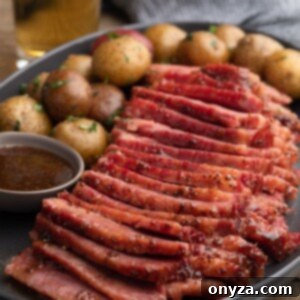
Rating: 5 from 21 votes
Author: Amanda Biddle
This low-and-slow corned beef brisket is exceptionally tender and flavorful. Finish the dish by broiling the corned beef with an Irish whiskey, brown sugar, and mustard glaze for a festive twist on a classic.
Prep Time: 10 minutes
Cook Time: 3 hours 20 minutes
Total Time: 3 hours 30 minutes
Servings: 6 people
Ingredients
Corned Beef
- 4 to 5-1/2 pound flat cut corned beef brisket, rinsed well
- 1 large yellow onion, peeled, halved, and sliced
- 4 cloves garlic, peeled and lightly crushed with the back of a knife
- 2 pints lager (nothing with heavy bitter notes)
- 1 cup water, plus additional (if needed)*
- 1 tablespoon pickling spice (or use the spice packet provided with your corned beef)
Glaze
- ¼ cup dark brown sugar, lightly packed
- 2 tablespoons whole grain Dijon mustard
- 1 tablespoon smooth Dijon mustard
- 1 tablespoon Irish whiskey
- ¼ teaspoon freshly-ground black pepper
- pinch ground cloves
Instructions
Cook the Corned Beef
- Preheat oven to 300 degrees F. Place sliced onion and garlic cloves in the bottom of a large Dutch oven (I use a 6-3/4 quart round wide Le Creuset). Lay corned beef on top of onions, fat cap side up. Add pickling spices or spice packet.
- Pour beer into pot, adding enough water to almost cover the brisket (see note below). Bring to a simmer on the stove. Cover tightly with the lid and cook for 3 hours in the oven, flipping the corned beef halfway through the cooking time and adding additional water to the pot, as needed, if evaporation occurs.
Glaze and Serve
- When the corned beef is almost finished braising, combine glaze ingredients in a bowl.
- Remove the corned beef from the braising liquid and pat dry with paper towels. (Reserve braising liquid in the pot.) If needed, trim the fat cap to a thickness of about 1/4 inch, so that you have a fairly even glazing surface.
- Lightly score fat side with a sharp knife in a crisscross pattern. Place in a broiler-safe pan or foil-lined rimmed baking sheet (for easy cleanup). Brush the top and sides of the brisket with the glaze.
- Place the pan or baking sheet on the oven rack 6-8 inches from the broiling element. Broil 4-5 minutes, until the glaze is bubbling. Repeat the process 2 more times, glazing and broiling the brisket for 2-3 minutes each time, until the glaze is caramelized. Important: broilers can vary in terms of intensity. Watch the corned beef carefully so it doesn’t burn!
- Slice corned beef against the grain. If desired, strain braising liquid and spoon over sliced meat upon serving.
Notes
The amount of water you add will depend on the dimensions of your pot and the proportions of the corned beef (thicker briskets will require more liquid than longer, thinner briskets). Adjust the liquid quantity as needed.
Your corned beef might look quite large when you purchase it, but will shrink as it cooks. Depending on its cooked size, you might have more glaze than you need. Extra glaze is delicious spread onto rye bread as a condiment for corned beef sandwiches, and can also be used to glaze chicken.
To cook cabbage and potatoes with the meat:
- One hour before the corned beef is finished braising, add 1-1/2 pounds whole baby red potatoes to the Dutch oven.
- With 30 minutes remaining, add 1 head of cabbage, cut into 8 wedges. (Optional: first sear cabbage wedges in a skillet with a bit of vegetable oil over medium-high heat until lightly browned, for extra flavor.)
- Remove cooked vegetables from braising liquid and keep warm while corned beef is being glazed. Drizzle with strained braising liquid when serving.
Nutrition Estimate
Nutrition information is automatically calculated, so should only be used as an approximation.
- Calories: 1312 kcal
- Carbohydrates: 18g
- Protein: 89g
- Fat: 89g
- Saturated Fat: 28g
- Cholesterol: 324mg
- Sodium: 7399mg
- Potassium: 1880mg
- Sugar: 9g
- Vitamin C: 163.8mg
- Calcium: 70mg
- Iron: 10.5mg
About Our Recipes
Please note that our recipes have been developed using the US Customary measurement system and have not been tested for high altitude/elevation cooking and baking.
Like this? Rate and comment below!
